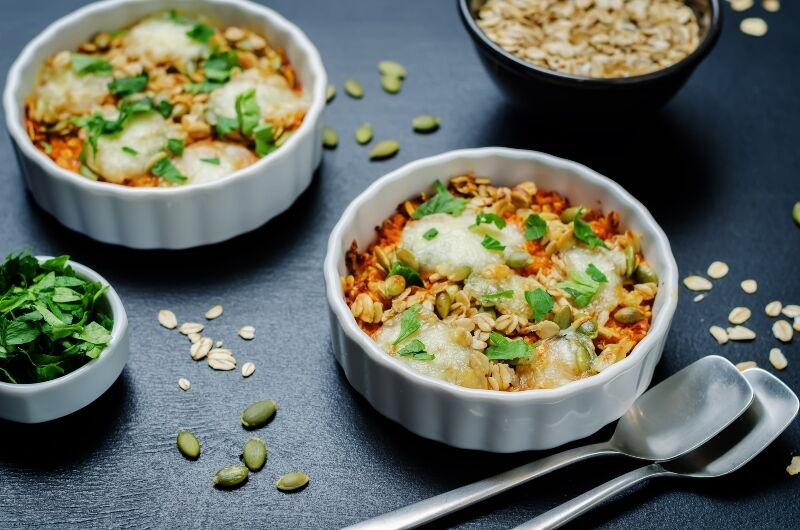Oats are a whole food, scientifically known as Avena sativa.
Oats are commonly eaten for breakfast as oatmeal.
With oatmeal , in fact, we mean a preparation of oats that have been peeled, steamed (in water but also in milk) and flattened, or a coarse flour made of hulled oat grains that have been ground or cut with steel. Ground oats are also called white oats or porridge.
Oatmeal is also often used for muffins, granola bars, cookies, and other baked goods.
In this article we will analyze the nutritional principles of this extraordinary food, oats precisely, what are its components and health benefits.

Nutritional principles
The nutritional composition of oats is scientifically considered to be well balanced.
It is a good source of carbohydrates and fibre, including the powerful fibre beta-glucan [1] [2] [3].
It also contains a higher percentage of Protein and fats than most cereals [4].
Oats are packed with important vitamins, minerals, and antioxidant plant compounds. Half a cup (78 grams) of dry oats contains [5]:
- Manganese: 191% of the RDI
- Phosphorus: 41% of the RDI
- Magnesium: 34% of the RDI
- Copper: 24% of the RDI
- Iron: 20% of the RDI
- Zinc: 20% of the RDI
- Folate: 11% of the RDI
- Vitamin B1 (thiamine): 39% of the RDI
- Vitamin B5 (pantothenic acid): 10% of the RDI
- Lower amounts of calcium, potassium, vitamin B6 (pyridoxine) and vitamin B3 (niacin)
All made with 51 grams of carbohydrates, 13 grams of protein, 5 grams of fat and 8 grams of fiber, but only 303 calories!
This means that oats are among the most nutritious foods you can eat.
Antioxidants
Whole oats are packed with antioxidants and beneficial plant compounds called polyphenols. Most notable is a unique group of antioxidants called avenantramid i, which are found almost exclusively in oats [6].
Avenanthramides can help reduce blood pressure levels by increasing nitric oxide production. This gas molecule helps dilate blood vessels and leads to better blood flow [7] [8] [9].
They also have anti-inflammatory and anti-itch effects.
Ferulic acid is also found in large quantities in oats. This is another antioxidant [10].
Beta Glucans
Oats contain large amounts of beta-glucans, a type of soluble fiber.
Beta-glucans partially dissolve in water and form a thick, gelatinous solution in the intestine.
The health benefits of beta-glucan fiber include:
- Reduced levels of LDL and total cholesterol [1]
- Reduced blood sugar and insulin response [11]
- Greater feeling of fullness [12]
- Increased growth of good bacteria in the digestive tract [13]
Oats and cholesterol
So let's analyze two of the main benefits of oats.
Heart disease is the leading cause of death globally. One of the main risk factors is high blood cholesterol.
Many studies have shown that the beta-glucans in oats are effective in reducing both total and LDL cholesterol levels [1] [14]. They can in fact increase the excretion of cholesterol-rich bile, thus reducing the circulating levels of cholesterol in the blood.
The oxidation of LDL (the "bad") cholesterol, which occurs when LDL reacts with free radicals, is another crucial step in the progression of heart disease. It produces inflammation of the arteries, damages tissues and can increase the risk of heart attacks and strokes.
One study reports that antioxidants in oats work together with vitamin C to prevent LDL oxidation [15].
Oats and blood sugar
Type 2 diabetes is a common disease characterized by significantly elevated blood sugars. It usually results from a reduced sensitivity to the hormone insulin. Oats can help reduce blood sugar levels, especially in people who are overweight or with type 2 diabetes [16] [17] [18].
It can also improve insulin sensitivity [19].
These effects are mainly attributed to the ability of beta-glucans to form a thick gel that delays stomach emptying and blood glucose absorption [20]
Conclusions
We have seen the benefits of oats, an extraordinary food to be included in our diet. To find out in which fantastic recipes it can be prepared, don't miss our blog in the recipes section!
References:
[1] https://pubmed.ncbi.nlm.nih.gov/25411276/
[2] https://www.ncbi.nlm.nih.gov/pubmed/19337540/
[3] https://www.ncbi.nlm.nih.gov/pubmed/22187640/
[4] https://www.ncbi.nlm.nih.gov/pubmed/22530714
[5] https://nutritiondata.self.com/facts/cereal-grains-and-pasta/5708/2
[6] https://pubmed.ncbi.nlm.nih.gov/19941618/
[7] https://pubmed.ncbi.nlm.nih.gov/16139284/
[8] https://pubmed.ncbi.nlm.nih.gov/15186945/
[9] https://pubmed.ncbi.nlm.nih.gov/18461339/
[10] https://www.sciencedirect.com/science/article/abs/pii/S0733521015000272
[11] https://pubmed.ncbi.nlm.nih.gov/18633670/
[12] https://pubmed.ncbi.nlm.nih.gov/24884934/
[13] https://pubmed.ncbi.nlm.nih.gov/26511097/
[14] https://pubmed.ncbi.nlm.nih.gov/7956987/
[15] https://pubmed.ncbi.nlm.nih.gov/15173412/
[16] https://pubmed.ncbi.nlm.nih.gov/18837470/
[17] https://pubmed.ncbi.nlm.nih.gov/12080401/
[18] https://pubmed.ncbi.nlm.nih.gov/16054549/
